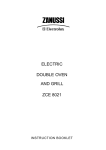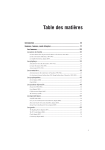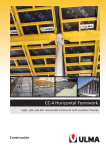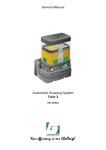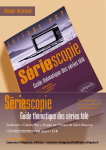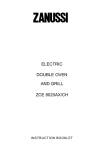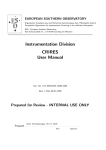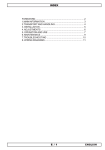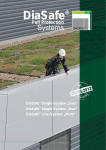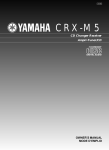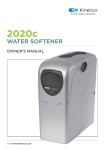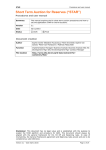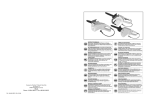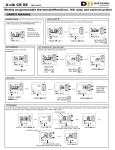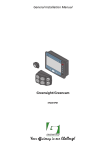Download PDF - Groeneveld CPL Systems
Transcript
General Manual Single Line Automatic Greasing Systems North American Market EG0102 Your efficiency is our challenge! your efficiency is our challenge All rights reserved. No part of this manual may be copied and/or published by means of printing, photocopying, microfilm or by any other means without prior written permission from Groeneveld. This applies also to the drawings and diagrams appended. Groeneveld reserves the right to change parts at any time, without prior or direct notice to the customer. The contents of this manual may also be changed without prior notice. This manual applies to the standard version of the product. Groeneveld cannot accept liability for any damage arising from the use of specifications other than that supplied. You are requested to contact Groeneveld technical service for information concerning adjustment, maintenance work or repairs that is not described in this manual. Whilst this manual has been prepared with the greatest possible care Groeneveld cannot accept responsibility for any errors of the concequences of such errors. Single Line General Manual 1. 1. Introduction - - - - - - - - - - - - - - - - - - - - - - - - - - - - - - - - - - - - - - - - - 7 1.1. 1.2. 1.3. 2. Conversions sizes and weights - - - - - - - - - - - - - - - - - - - - - - - - - - - 11 2.1. 2.2. 3. 4. System summary - - - - - - - - - - - - - - - - - - - - - - - - - - - - - - - - - - - - - 17 Date of issue: January 2004 24 24 26 27 27 28 29 29 31 Electronic timer - - - - - - - - - - - - - - - - - - - - - - - - - - - - - - - - - - - - - - - - Adjustment of the cycle time interval - - - - - - - - - - - - - - - - - - - - - - - Testing the electronic timer - - - - - - - - - - - - - - - - - - - - - - - - - - - - - - - Alarm signals - - - - - - - - - - - - - - - - - - - - - - - - - - - - - - - - - - - - - - - - - Technical data - - - - - - - - - - - - - - - - - - - - - - - - - - - - - - - - - - - - - - - - - - 34 34 35 35 36 Operation - - - - - - - - - - - - - - - - - - - - - - - - - - - - - - - - - - - - - - - - - - - - - 38 Setting the number of brake applications - - - - - - - - - - - - - - - - - - - - - 39 Technical data - - - - - - - - - - - - - - - - - - - - - - - - - - - - - - - - - - - - - - - - - - 39 Metering units - - - - - - - - - - - - - - - - - - - - - - - - - - - - - - - - - - - - - - 41 8.1. 8.2. 8.3. 8.4. 8.5. EG0102 Pneumatically operated piston pump - - - - - - - - - - - - - - - - - - - - - - - Pump unit - - - - - - - - - - - - - - - - - - - - - - - - - - - - - - - - - - - - - - - - - - - - Technical data - - - - - - - - - - - - - - - - - - - - - - - - - - - - - - - - - - - - - - - - - Electrically operated gear pump - - - - - - - - - - - - - - - - - - - - - - - - - - - Pump unit - - - - - - - - - - - - - - - - - - - - - - - - - - - - - - - - - - - - - - - - - - - - Technical data - - - - - - - - - - - - - - - - - - - - - - - - - - - - - - - - - - - - - - - - - Electric axial plunger pump - - - - - - - - - - - - - - - - - - - - - - - - - - - - - - - Pump unit - - - - - - - - - - - - - - - - - - - - - - - - - - - - - - - - - - - - - - - - - - - - Technical data - - - - - - - - - - - - - - - - - - - - - - - - - - - - - - - - - - - - - - - - - - Pneumatic impulse counter - - - - - - - - - - - - - - - - - - - - - - - - - - - - - 37 7.1. 7.2. 7.3. 8. 18 18 19 20 21 22 Electronic timer - - - - - - - - - - - - - - - - - - - - - - - - - - - - - - - - - - - - - - 33 6.1. 6.2. 6.3. 6.4. 6.5. 7. System with pneumatically operated pump and electronic timer/PLC System with pneumatically operated pump and impulse counter - - - System with pneumatically operated impulse counter - - - - - - - - - - - System with electrically operated impulse counter - - - - - - - - - - - - - - System with electrically operated pump - - - - - - - - - - - - - - - - - - - - - System with electric plunger pump - - - - - - - - - - - - - - - - - - - - - - - - - - Pumps - - - - - - - - - - - - - - - - - - - - - - - - - - - - - - - - - - - - - - - - - - - - - 23 5.1. 5.1.1. 5.1.2. 5.2. 5.2.1. 5.2.2. 5.3. 5.3.1. 5.3.2. 6. Sizes and weights conversions - - - - - - - - - - - - - - - - - - - - - - - - - - - - - - 12 Temperature conversions - - - - - - - - - - - - - - - - - - - - - - - - - - - - - - - - - 13 Principle of operation - - - - - - - - - - - - - - - - - - - - - - - - - - - - - - - - - 15 4.1. 4.2. 4.2.1. 4.2.2. 4.3. 4.4. 5. GROENEVELD Transport Efficiency B.V. - - - - - - - - - - - - - - - - - - - - - - - - 8 GROENEVELD Greasing Systems - - - - - - - - - - - - - - - - - - - - - - - - - - - - - - 8 Single Line Automatic Greasing Systems - - - - - - - - - - - - - - - - - - - - - - - 9 q^_ib=lc=`lkqbkqp Preface - - - - - - - - - - - - - - - - - - - - - - - - - - - - - - - - - - - - - - - - - - - - - 5 Types of metering units - - - - - - - - - - - - - - - - - - - - - - - - - - - - - - - - - - Operating principle - - - - - - - - - - - - - - - - - - - - - - - - - - - - - - - - - - - - - Phase A - - - - - - - - - - - - - - - - - - - - - - - - - - - - - - - - - - - - - - - - - - - - - - Phase B - - - - - - - - - - - - - - - - - - - - - - - - - - - - - - - - - - - - - - - - - - - - - - Phase C - - - - - - - - - - - - - - - - - - - - - - - - - - - - - - - - - - - - - - - - - - - - - - - 42 43 43 44 44 Table of contents 3 Single Line General Manual 9. Other components - - - - - - - - - - - - - - - - - - - - - - - - - - - - - - - - - - - 45 9.1. 9.1.1. 9.2. 9.2.1. 9.3. 9.4. Solenoid valve - - - - - - - - - - - - - - - - - - - - - - - - - - - - - - - - - - - - - - - - - Technical data - - - - - - - - - - - - - - - - - - - - - - - - - - - - - - - - - - - - - - - - - Pressure switch - - - - - - - - - - - - - - - - - - - - - - - - - - - - - - - - - - - - - - - - Technical data - - - - - - - - - - - - - - - - - - - - - - - - - - - - - - - - - - - - - - - - - Reservoir - - - - - - - - - - - - - - - - - - - - - - - - - - - - - - - - - - - - - - - - - - - - - Follower plate - - - - - - - - - - - - - - - - - - - - - - - - - - - - - - - - - - - - - - - - - - 46 46 47 47 48 48 10. Refilling the reservoir - - - - - - - - - - - - - - - - - - - - - - - - - - - - - - - - - 49 11. Maintenance - - - - - - - - - - - - - - - - - - - - - - - - - - - - - - - - - - - - - - - - 51 12. Fault diagnosis - - - - - - - - - - - - - - - - - - - - - - - - - - - - - - - - - - - - - - 53 Date of issue: January 2004 4 Table of contents EG0102 Single Line General Manual 3. 2. Date of issue: January 2004 PREFACE your efficiency is our challenge Your efficiency is our challenge! EG0102 Preface 5 Single Line General Manual This general manual is a description of the Singleline Automatic Greasing System. The intention is to provide clients with an insight into how the system works, what the possibilities are and, briefly, maintenance aspects. Furthermore, you will find the technical data of the various parts of the lubrication system in this manual. The general manual can also be used as a user manual. The manual is built up of different sections, indicated by chapter numbers. The numbering of pages and the images re-starts with every new chapter. In this manual, the following pictograms are used to bring an item to the user’s attention or to notify the user. ATTENTION: ATTENTION: Important supplementary information is provided for the user, in users the hopes of Important supplementary information is brought to the attention, so preventing errors from occurring. trying to prevent problems occurring. WARNING: WARNING: This pictogram notifies the user when the danger of physical injury or seThis pictogram notifies the user when the danger of physical injury or vere damage to the apparatus by inadequate operation is threatened. severe damage by improper use should arise. Date of issue: January 2004 6 Preface EG0102 Single Line General Manual 4. 1. Date of issue: January 2004 INTRODUCTION your efficiency is our challenge Your efficiency is our challenge! EG0102 Introduction 7 Single Line General Manual This chapter is a short presentation of GROENEVELD Transport Efficiency and its products. The chapter ends with some general remarks about the Singleline greasing systems. 1.1 GROENEVELD Transport Efficiency B.V. Investing in operational safety. With this thought in mind, GROENEVELD was founded in 1971. The present, international network is administered from its headquarters in Gorinchem. GROENEVELD strives for an expansion of its leading position, achieved by the company’s solid image and customer-oriented policy. GROENEVELD employees form enthusiasm and and GROENEVELD form aa team team that that daily worksworks everywith daygreat with great enthusiam dedication for its customers. Extensive automation makes a high working rate possible. The ISO 9001 standard is the basis for the guaranteed quality of GROENEVELD products. Frequent contact with clients and an extensive dealer network guarantee the good name of GROENEVELD. We know what the entrepreneur needs today, not a ready-made product, but a custom-made solution for automation. New technologies offer new applications. Therefore GROENEVELD has a large budget available for the development of new cost-saving products. Our Research and Development department not only collaborates with leading external organizations, but also with leading manufacturers of vehicles and machinery. In addition to the Automatic Greasing System, GROENEVELD also delivers products such as: • speed limiters • on-board computer systems • automatic oil level controllers • reversing protection systems • temperature recording systems GROENEVELD delivers a complete program of cost-saving and comfort-enhancing products. 1.2 Date of issue: January 2004 Figure 1.1 GROENEVELD Head office GROENEVELD Greasing Systems GROENEVELD Automatic Greasing Systems ensure the daily maintenance of everything that has moving parts. They avoid unnecessary machinery wear and downtime and,thus,save cost and prevent exasperation. 8 Introduction EG0102 Single Line General Manual GROENEVELD greasing systems are used by, for example, production companies, machinery used in service industries, agriculture, ships, the offshore industry and the transport industry. In the following list are the most important advantages: • increase of the service intervals, thus,less unnecessary down-time; • less wear of the lubricated parts because of accurate and constant lubricating; • reduced repair and replacement costs; • reduced unexpected down-time; • fewer production losses. 1.3 Single Line Automatic Greasing Systems With a Single Line Automatic Greasing System, all lubrication points of a vehicle or machine are automatically lubricated at the correct time with the correct dose. Moreover, optimum grease or lube-oil distribution over the whole lubricating surface is achieved, because the lubrication takes place while the machinery or vehicle is in operation. Every action is automatically carried out by the system. The user needs only to refill the reservoir periodically. The GROENEVELD Automatic Greasing Systems are designed with great care and thoroughly tested to guarantee a long and fault-free life span, under the most heavy operational conditions. A well-functioning system requires: • correct assembly; • use of the prescribed type of grease or lube oil; • a periodic check of the functionality of the system. The periodic check can easily be carried out at the same time as the normal maintenance of the machine or vehicle. Moreover, because of the careful choice of materials, the greasing system is nearly maintenance-free. ATTENTION: Date of issue: January 2004 An automatic greasing system avoids the time-consuming manual lubricating of important parts. Remember, however, that there can be lubricating points that still have to be lubricated manually. EG0102 Introduction 9 Single Line General Manual Notes Date of issue: January 2004 10 Introduction EG0102 Single Line General Manual 5. 2. Date of issue: January 2004 CONVERSIONS SIZES AND WEIGHTS your efficiency is our challenge Your efficiency is our challenge! EG0102 Conversions sizes and weights 11 Single Line General Manual 2.1 Sizes and weights conversions Metric SAE 1 bar = 14,7 psi 1 kilogram = 2,2 lbs 1 cubic centimeter = 0,061 cubic inches 1 liter = 0,26 US gallon 1 liter = 0,22 Imperial gallon 1 millimeter = 0,03937 inch 1 psi = 0,068 bar 1 lbs = 0,454 kilogram 1 cubic inch = 16,4 cubic centimeter 1 US gallon = 3,79 liters 1 Imperial gallon = 4,55 liters 1 inch = 25,4 millimeters Celsius = (°F - 32) + 1,8 Fahrenheit = (°C x 1,8) + 32 Date of issue: January 2004 12 Conversions sizes and weights EG0102 Single Line General Manual Temperature conversions Celsius Fahrenheit -45 -49 -40 -40 -35 -31 -30 -22 -25 -13 -20 -4 -15 5 -10 14 -5 23 0 32 5 41 10 50 15 59 20 68 25 77 30 86 35 95 40 104 45 113 50 122 Date of issue: January 2004 2.2 EG0102 Conversions sizes and weights 13 Single Line General Manual Notes Date of issue: January 2004 14 Conversions sizes and weights EG0102 Single Line General Manual 6. 3. Date of issue: January 2004 PRINCIPLE OF OPERATION your efficiency is our challenge Your efficiency is our challenge! EG0102 Principle of operation 15 Single Line General Manual Each system consists of a pump with an integral reservoir, a control unit, a main pipe, one or more metering unit blocks, metering units, secondary piping and connectors. Lubricant is transferred from the reservoir by the pump, via the main pipe, to the metering unit blocks. Each metering unit is connected by a secondary pipe to a lubrication point. An electronic timer, timer, PLC PLC or ora apneumatically-operated pneumatically operated impulse counter, depending impulse counter, depending on on whether there is a continuous electrical supply available, is used to determine when lubrication occurs. Generally only trailers and semi-trailers are equipped with a pneumatic (brake) impulse counter since they usually do not have a continuous electrical supply. There are are two main types types of There two main of pump: pumps: • electrically-operated electrically operatedpumps pumps(with (withelectronic electronictimer timeror orPLC); PLC) • pneumatically-operated pneumatically operatedpumps pumps (with electronic timer, or pneumatic (with electronic timer, PLC PLC or pneumatic impulse counter). impulse counter). The electrically operated pump is used mainly for installations or vehicles without a compressed air supply. The electrically -operated pump is also used for installations where a large lubricant delivery is required. The delivery is larger as the pump operates for longer periods. Date of issue: January 2004 16 Principle of operation EG0102 Single Line General Manual 7. 4. Date of issue: January 2004 SYSTEM SUMMARY Yourefficiency efficiencyis isour our challenge challenge! your EG0102 System summary 17 Single Line General Manual 4.1 System with pneumatically -operated pump and electronic timer/PLC Figure 4.1 System with pneumatically-operated pump and electronic timer (schematically) At a time preset by the electronic timer, the circuit to the solenoid valve is closed. The solenoid valve opens and allows compressed air from the compressor to flow to the pump. The pump piston now rises under compressor pressure and forces grease into the system. The lubricant pressure is dependent upon the air pressure on the piston (this is the compressor pressure). With a compressor pressure of 125 psi and for a pump with 9:1 ratio, the grease pressure is 1125 psi. The metering units then simultaneously pass a fixed, pre-selected metered quantity of grease to the points to be lubricated. To end the lubrication cycle the electronic timer or PLC opens the electrical circuit closing the solenoid valve. Therefore ,the compressed air supply to the pump is shut off and the piston reverts to atmospheric pressure. This allows the piston to return to its starting position and the whole system is depressurized. The metering units are then able to automatically refill themselves and are then (after a minimum delay of 2 minutes) ready for the next lubrication cycle. System with pneumatically-operated pump and impulse counter As a rule, trailers and semi-trailers are equipped with a pneumatic (brake) impulse counter and not with an electronic timer or PLC. This is because of a lack of a continuous electrical supply. The standard version of the brake impulse counter is pneumatically-operated and uses the air signal from the service line which is usually connected to the number 4 position of the trailer relay valve. This position may differ in the different countries; please contact your local dealer or GROENEVELD. In certain situations the signal line can be too long, as is the case with extended semi-trailers. Another relay valve is then installed in the fixed part of the semi-trailer. Alternatively ,an electrical version of the pneumatic impulse counter can be used, which operates through the brake-light circuit. 18 System summary EG0102 Date of issue: January 2004 4.2 Single Line General Manual 4.2.1 System with pneumatically-operated impulse counter Figure 4.2 System with pneumatically-operated impulse counter (schematically) Date of issue: January 2004 The vehicle air tank is connected to input P of the pneumatic impulse counter. Always draw air from the auxiliary tank. Port A on the pneumatic impulse counter is connected to the compressed air connection on the underside of the pump. Port R on the pneumatic impulse counter is connected to the vent above the main piston. The other connection on this double banjo-union is an open vent. EG0102 System summary 19 Single Line General Manual 4.2.2 System with electrically-operated impulse counter Figure 4.3 System with electrically-operated impulse counter (schematically) This corresponds broadly with that of a pneumatically operated impulse counter. The signal impulse is derived from an electric signal. Date of issue: January 2004 20 System summary EG0102 Single Line General Manual 4.3 System with electrically-operated pump Figure 4.4 System with electrically-operated pump (schematically) Date of issue: January 2004 At a time set by the electronic timer or PLC, a gear pump under the grease reservoir is started. The lubricant is pumped from the reservoir via the main pipe, to the metering unit blocks. The metering units then simultaneously allow a measured quantity of lubricant to be pressurized to the points to be lubricated. A pressure bypass valve keeps the system at a preset pressure during the pumping cycle. To end the lubrication cycle, the electronic timer or PLC opens the electrical circuit, the gear pump then stops. Pressure in the output main (primary) pipe to the metering units then falls by means of a built-in pressure discharge valve. The metering units then automatically refill themselves after which they are ready for the next lubrication cycle. EG0102 System summary 21 Single Line General Manual 4.4 System with electric plunger pump Figure 4.5 System with electric plunger pump (schematically) 22 System summary EG0102 Date of issue: January 2004 GROENEVELD Automatic Greasing Systems with electrically-driven pumps are usually employed on vehicles or machines on which electric power is always available. An electric pump is also the best choice if the lubricant demand of the system is high. The control unit - an advanced electronic timer, for instance - holds a number of system control variables, such as the lubrication interval and the duration of the lubrication cycle. The control unit is able to process and store all functional errors that may occur and automatically maintains an electronic log book. If the greasing system requires action, the controller will generate an alarm signal (i.e. if the reservoir needs to be refilled). At a given point in time, the control unit will start the pump and lubricant will be pressed through the primary line to the distributors and, consequently, to the dosage metering units. Each metering device then forces - powered by the grease pressure - an exact amount of grease through the secondary lines to the grease points. All metering units act simultaneously. The amount of lubricant that goes to each of the grease points depends on the type of metering device installed. A pressure control valve - built into the pump unit - maintains a constant pressure of 1500 psi in the system during the lubrication cycle (i.e. while the pump runs). If the grease pressure exceeds 1500 psi this valve will redirect the grease back toward the reservoir. During the lubrication cycle, the integrated pressure switch must report to the control unit that the required pressure has been attained (at least 1029 psi). If the control unit does not receive this signal it will generate an alarm signal. The lubrication cycle ends when the control unit stops the pump. The pressure in the primary line then slowly drops to zero, via an electrically- controlled relieve valve. The metering units will then be able to reset themselves and will be ready for the next lubrication cycle after about two minutes. Single Line General Manual 8. 5. Date of issue: January 2004 PUMPS Your efficiencyisisour ourchallenge challenge! your efficiency EG0102 Pumps 23 Single Line General Manual 5.1 Pneumatically -operated piston pump 5.1.1 Pump unit 1. 2. 3. 4. 5. 6. 7. 8. 9. 10. 11. 12. 13. 14. 15. 16. 17. reservoir with follower plate air venting channel grease channel return channel to reservoir main line connection pressure channel return valve non-return valve grease pressure colour color indicator indicator compressed air connection main air piston spring filler connector small grease piston grease chamber flapper valve connection to reservoir Date of issue: January 2004 Figure 5.1 24 Pumps Pneumatically-operated pump EG0102 Single Line General Manual Date of issue: January 2004 If pressure is applied via the compressed air connection (10) the main piston (11) will be forced upwards applying pressure to the lubricant in chamber (15). The pressure in chamber (15) forces valve (16) against the seat. The connection (17) to the reservoir (1) is thus closed. The lubricant leaves the chamber (15) via a channel (3) through the non-return valve (8) into the main or primary line. The metering units are brought under full pump pressure passing their metered quantities of lubricant into the lubrication points. As a result of the pressure differential at the return valve (7) the return channel (4) remains closed. At the end of the complete lubrication cycle the air pressure under the main piston (11) falls, allowing the piston to be pushed downward by the spring (12). At the same time flapper valve (16) is released and, because of the reduced pressure in the chamber (15), lubricant is drawn from the reservoir. The non-return valve (8) prevents grease from the system piping and metering units from flowing back into the chamber (15). The pressure in the main pipe opens the return valve (7) via the channel (6). This allows the pressure of the lubricant to flow via the channel (4) to the reservoir. The metering units, with this pressure drop can now automatically refill themselves following which, they are ready for the next lubrication cycle. A manometer can be connected to the lubricant channel showing the pressure in indithe main line. It is also possible to replace this manometer by a pressure colour color indicator (9). At the start of the lubrication cycle, this will be red as a result of the air pressure, and will change to green at the end of the cycle, due to the pressure. Green,thus, indicates that the pump has worked and that sufficient pressure has built up in the grease line system. If the color remains red, this means that insufficient pressure has built up in the system. This could be caused by leakage from the main line. EG0102 Pumps 25 Single Line General Manual 5.1.2 Technical data Grease pumps: part number reservoir capacity 36201 68801 35501 4 liters 6 liters 8 liters delivery 42 cc / stroke ratio grease pressure 9:1 1125 psi (for an air pressure of 125 psi) maximum grease pressure temperature range weight 1500 psi -13°F to +176°F (NLGI 0 grease) 13.86 lbs 14.85 lbs 15.84 lbs part number 37101 reservoir capacity 4 liters delivery weight 8 liters 9:1 1125 psi (for an air pressure of 125 psi) maximum grease pressure temperature range 6 liters 60 cc / stroke ratio grease pressure 43001 1500 psi -13°F to +176°F (NLGI 0 grease) 16.54 lbs 17.53 lbs 18.52 lbs Oil pumps: part number reservoir capacity 00511 06511 4 liters 8 liters delivery 42 cc / stroke oil pressure 9:1 1125 psi (for an air pressure of 125 psi) maximum grease pressure 1500 psi temperature range weight 26 Pumps -13°F to +176°F 13.32 lbs 14.3 lbs EG0102 Date of issue: January 2004 ratio Single Line General Manual 5.2 Electrically -operated gear pump 5.2.1 Pump unit Date of issue: January 2004 1. 2. 3. 4. 5. 6. 7. 8. 9. 10. 11. follower plate low level indicator switch pressure control valve connector fitting vent opening main pipe line connector pressure switch connection electro-motor filler connector gear pump reservoir Figure 5.2 EG0102 Electrically-operated pump Pumps 27 Single Line General Manual The gear pump (9) is activated by the electronic timer. The lubricant will now be pumped from the reservoir (10) through the main pipe line (6) to the metering unit distribution blocks. The pump remains in operation throughout the entire cycle period. This cycle or impulse period is 3 minutes, when the standard version of the electronic timer is used. The pump builds up the lubricant pressure during the cycle. When the pressure reaches 838 psi, the pressure control valve (3) opens, lubricant is then no longer pumped into the main line but returns to the reservoir. The pressure is thus limited to 838 psi. The standard version of the electrically- operated pump is fitted with a pressure switch (7). If, during the lubrication cycle, the pressure does not rise above 588 psi the electronic timer or PLC will sound an alarm signal. A level indicator switch (2) (not in all versions) provides an alarm signal if the lubricant in the reservoir falls below a certain minimum level. On the right-hand side between the connector for the primary line (6) and the connector fitting (4),there is a right-angle connector for air venting and overflow (5). When filling the reservoir with lubricant the air above the follower plate escapes. This air flows downward through an opening in the piston line and leaves the pump via the right-angle connector (5). The escape of a small quantity of lubricant via this connector during venting is quite normal. (A version with the connections for the primary line and for the connector on the left-hand side of the pump can also be supplied if required.) 5.2.2 Technical data Gear pump: part number without level indicator switch: 530.01 (12 V) 522.01 (24 V) with level indicator switch: 531.01 (12 V) 523.01 (24 V) current consumption 8A 4A reservoir capacity 2.7 litres 2.7 litres delivery 120 cc/minute (NLGI 0 grease) at 20 °C 120 cc/minute (NLGI 0 grease) at 20 °C grease pressure 855 psi 855 psi temperature range -4°F to +158°F (NLGI 0 grease) -4°F to +158°F (NLGI 0 grease) at extreme circumstances ,please consult your local organization GROENEVELD-organization 28 Pumps 14.74 lbs Date of issue: January 2004 weight 14.74 lbs EG0102 Single Line General Manual 5.3 Electric axial plunger pump 5.3.1 Pump unit follower piston reservoir guide rod of follower level switch plunger pump coupling for primary grease line electric connector pressure switch electric motor return valve filler port overflow port filter pressure control valve Date of issue: January 2004 1. 2. 3. 4. 5. 6. 7. 8. 9. 10. 11. 12. 13. 14. Figure 5.3 EG0102 The electric plunger pump Pumps 29 Single Line General Manual The actual pump (5) of the unit consists of six fixed cylinders amid a ring duct. The six plungers are driven by the electric motor (9) through a mechanical transmission. In the channel between the ring duct and the output port (6) of the pump unit, a pressure control valve (14) and an electrically operated return valve (10) have been incorporated. The pressure control valve is used to maintain a constant grease pressure during the pump cycle. The return valve allows the grease pressure in the system to fade after the pump cycle has ended. The standard electric plunger pump is fitted with a pressure switch (8) which is used to check that the required grease pressure is attained during the pump cycle. The optional low level switch (4) in the reservoir will cause the control unit to generate an alarm signal when the level of the lubricant in the reservoir becomes too low and needs to be replenished. The pump is electrically-connected with the control unit through a connector (7). The reservoir (2) is mounted on top of the pump unit. The reservoir is filled via the filler port (11) at the side of the pump unit. A filter (13) prevents contaminations from entering the reservoir. Any bubbles of air that might be introduced in the lubricant while filling the reservoir can escape to the space above the follower piston (1) through the overflow port (12) and a channel in the guide rod (3). If the reservoir is - inadvertently - filled to a level above its maximum level, this excess lubricant is also allowed to escape in this way. Date of issue: January 2004 30 Pumps EG0102 Single Line General Manual 5.3.2 Technical data Grease pump: partnumber 160.22 161.22 162.22 214.22 315.22 339.22 50 25 25 50 25 25 1500 psi 1500 psi 1500 psi 1500 psi 1500 psi 1500 psi content reservoir (litres) 8 8 4 4 4 4 supply voltage (V dc) 12 24 24 12 12 24 nominal current (A) 8 4 4 8 8 4 grease output (cc/min) (see remark) max. grease pressure (psi) electrical connection (connector): pin 1: plus pin 2: minus pin 3: grease pressure switch pin 4: grease level switch 4-pin follower piston in reservoir yes yes yes yes yes yes integrated pressure switch yes yes yes yes yes yes optional optional optional optional optional optional level switch operating temperatures (°F): 0-grease 00, 000, or of +23°F . . . . +176°F LT-grease (operating temperatures below +5°F) weight 21.56 lbs 21.56 lbs 19.36 lbs 19.36 lbs 19.36 lbs 19.36 lbs REMARK: Date of issue: January 2004 The output of the pump is specified in cubic centimetres per minute. If the greasing system is to operate properly however, the pump should have supplied the total quantity of grease required by the system before 70% of the lubrication cycle has expired. The length of the cycle must be set accordingly. This will guarantee that the grease pressure reaches a value of at least 1176 psi and that the pressure switch in the pump will report this fact to the control unit. If the control unit does not receive this signal, it will generate an alarm signal. EG0102 Pumps 31 Single Line General Manual Oil pumps: part number 61522 (24Vdc) F172672 (24Vdc) current consumption 4A 4A reservoir capacity 4 liters 8 liters delivery 50 cc/minute at +68°F 50 cc/minute at +68°F oil pressure 855 psi 855 psi temperature range -4°F to +158°F -4°F to +158°F at extreme circumstances ,please consult your local organization GROENEVELD-organization weight 20.24 lbs 22.44 lbs Date of issue: January 2004 32 Pumps EG0102 Single Line General Manual 9. 6. Date of issue: January 2004 ELECTRONIC TIMER your efficiency Your efficiencyisisour ourchallenge challenge! EG0102 Electronic timer 33 Single Line General Manual 6.1 Electronic timer 687.01 Figure 6.1 Electronic timer The greasing system (with a pneumatically-operated or electrically-operated pump) can be controlled by an electronic timer (Figure 6.1). The timer produces, at set time intervals impulses lasting 3 minutes. These impulses energize the solenoid valve in the air supply to start the lubrication cycle. With an electrically operated pump the impulses start the pump. The interval between successive lubrication cycles is adjusted on the electronic timer. If during a cycle the power supply is switched off, a complete new lubrication cycle will restart when the power supply is again switched on. The electronic timer has a memory in which data is stored even after switching off the power supply. The data stored is as follows: • interval duration • impulse duration • conditions for an alarm signal • total number of cycles since first fitted • total number of alarm signals since first fitted • longest series of successive alarm signals in a certain period • remaining interval time The data in the memory can be recovered using a special test or read-out unit. This device should be connected via the socket on the left-hand side of the timer. Adjustment of the cycle time interval The interval time between two successive lubrication cycles can be adjusted using the step switch. One of ten time intervals can be selected. The standard version has time intervals increasing by 0.5 h steps (0.5 h, 1 h, 1.5 h etc. to 5 h). If the power supply is switched off during a cycle the cycle will be ended. When the power supply is switched on again a complete new cycle will be started. 34 Electronic timer EG0102 Date of issue: January 2004 6.2 Single Line General Manual 6.3 Testing the electronic timer The various electronic timer functions can be tested as follows: Test 1, step switch test: • • • • • • • • This test checks the step switch contacts in all positions. Set the step switch to position ‘test A’. Activate the electronic timer by switching on the ignition. Press the ‘test’ button. Wait for the audible alarm signal then release the ‘test’ button. Within 5 seconds turn the step switch to the required interval time position. Each position produces a number of signals: position 1 gives one signal, position 2 two signals etc. The switch can be set to all positions; positions ‘test A’ and ‘test B’ will not produce an alarm signal. End the test by switching off the ignition. Test 2, accelerated cycle test: • • • • • • • Set the step switch to position ‘test A’. Press and hold the ‘test’ button. Switch the ignition on while still keeping the ‘test’ button pressed in. The alarm signal buzzer will now sound. The ‘test’ button must be pressed as long as the alarm signal continues. Within 5 seconds of the end of the alarm signal turn the step switch to the required position. The electronic timer is now fully operational; the time intervals are now 1/ 20 of their usual times. End the test by switching off the power supply. Test 3, normal system test: • • Switch the ignition on. Press the ‘test’ button; a normal lubrication cycle will then follow. The switch can be set in any position except ‘test A’ or ‘test B’. After this test the electronic timer will work at the interval set. The ‘test B’ position is only for use with the test or read-out unit. 6.4 Alarm signals Date of issue: January 2004 Alarm signals can be generated by the electronic timer in various circumstances. The standard version uses a built-in buzzer. In other versions another (external) alarm indicator can be fitted, for example a lamp. The alarm signal is generated in the following situations: • After reaching 70% of the cycle time (70% of 3 minutes = 2 minutes) the pressure switch should have connected to earth. If this is not the case because insufficient pressure has been built up - then a continuous alarm signal is generated. • If a level indicator switch is fitted to an electrically- operated pump, an intermittent alarm is generated when the level of the lubricant in the reservoir falls below a set minimum. This signal will be generated throughout the entire cycle. If, moreover, insufficient pressure is built up, the pressure alarm will take over after 2 minutes, causing a change in the frequency of the alarm signal. • The electronic timer runs a self-test after the power supply is switched on; if there is a fault condition an intermittent alarm is generated. This can occur if no interval is selected by the step switch. EG0102 Electronic timer 35 Single Line General Manual If the electronic timer sounds an alarm to indicate that the timer or greasing system is not functioning properly, it is strongly advised to examine (or have examined) the greasing system and,if necessary,to make repairs. If this is left too long, damage can be caused to either the installation or the greasing system. 6.5 Technical data part number 099.01 (12 V) cycle time cycle intervals alarm 032.01 (24 V) 676.02 (12V) 675.02 (24V) 678.02 (12V) 677.02 (24V) 3 minutes 2 minutes 3 minutes steps of 30 minutes (0.5 - 5 h) steps of 5 minutes steps of 30 minutes built-in buzzer internal relay (16A) internal relay(16A) Date of issue: January 2004 36 Electronic timer EG0102 Single Line General Manual 10. 7. Date of issue: January 2004 PNEUMATIC IMPULSE COUNTER your challenge Yourefficiency efficiency is is our our challenge! EG0102 Pneumatic impulse counter 37 Single Line General Manual 7.1 Operation 1 2 P A R solenoid valve screw for manual operation (test) compressed air connection pump connection venting outlet Figure 7.1 1 2 P A R Electrically-operated brake impulse counter signal air screw for manual operation (test) compressed air connection pump connection venting outlet Figure 7.2 Pneumatically-operated brake impulse counter 38 Pneumatic impulse counter EG0102 Date of issue: January 2004 The pneumatic impulse counter starts the lubrication cycle after a set number of pulses. The electrically -operated counter (Figure 7.1) is activated by an electric signal. The solenoid valve of the pneumatic impulse counter is energized, causing the operating cam to be rotated. With a pneumatically-operated impulse counter (Figure 7.2) activation is through pulses from the pneumatic system before the relay valve. The compressed air operates a piston, which in turn rotates the operating cam. After a preset number of pulses the operating cam opens the air valve through which compressed air passes to the pump. The lubrication cycle then begins. After a further number of pulses, depending on the setting of the counter, the pump is vented through the venting outlet R. Single Line General Manual 7.2 Setting the number of brake applications Figure 7.3 Setting the brake impulse The number of pulses required for the counter to activate the pump, is set as follows: • Remove the transparent cover. • Set the distance (Figure 7.3) between the left-hand side of the striker (1) and the head of the adjusting bolt (2). The distances equivalent to a specific number of pulses are shown on the transparent cover. A feeler-gauge (3) is fixed to the inside of the cover and can be used to set this distance. The tool is marked with the number of pulses related to each thickness. • Tighten the adjustment bolt lock nut (4). • Replace and secure the cover. REMARK: Setting the pneumatic impulse counter is easier when the pneumatic line is under pressure. This moves the cam striker to the right so that the distance between the striker and the adjustment bolt can be measured. 7.3 Technical data part number Date of issue: January 2004 074.01 pneumatically operated EG0102 003.01 electrically operated cycle time minimum 2 brake impulses minimum 2 brake impulses cycle intervals 10 - 80 brake impulses 10 - 80 brake impulses Pneumatic impulse counter 39 Single Line General Manual Notes Date of issue: January 2004 40 Pneumatic impulse counter EG0102 Single Line General Manual 11. 8. Date of issue: January 2004 METERING UNITS Your efficiency ourchallenge challenge! your efficiency isisour EG0102 Metering units 41 Single Line General Manual Figure 8.1 Distribution block with metering units Linesystem, system, each with There are 11 metering unit types (1) available for the Single Singleline each with a differing metered lubricant quantity. By careful selection of the type of metering unit each lubrication point can be provided with the right quantity of lubricant. The metering units are fitted in groups on distribution blocks (2); this is a cast brass distribution block to which the primary (main) line(3) is connected. The blocks are available with several ports or outlets to which metering units can be connected. The unused outlets should be blanked-off. The metering units are also made of brass and are, because of their enclosed design, exceptionally suitable for use in dirty and dusty conditions. It is not advisable to open the metering units as this allows the entry of dirt, and, thus,is a potential cause of faults. 8.1 Types of metering units The delivery (per lubrication cycle) of a metering unit is determined by the number and thickness of the spacers mounted between the head and the housing of the metering unit (Figure 8.2). The following metering units are available: Date of issue: January 2004 Figure 8.2 42 Metering units Types of metering units EG0102 Single Line General Manual 8.2 Operating principle Figure 8.3 Metering unit in initial position Figure 8.3 illustrates a new metering unit, one that has not yet been filled with grease. Item (1) in this figure is the spacer, which determines the delivery of the metering unit (see previous paragraph). The metering units that are used in your greasing system may differ externally, or even internally, from the one illustrated here. However, the operating principle is always the same. Date of issue: January 2004 8.3 Phase A Figure 8.4 Metering unit in phase A The pump presses the grease into grease channel (1). The grease pushes plunger (4) past channel (2). The grease now fills chamber (3) and pushes plunger (5) to the right. The stroke length of plunger (5) will determine the amount of grease that will be pressed through the secondary grease line to the grease point. This stroke length - hence the capacity of chamber (3) – is determined by the number and thickness of the spacers (Figure 8.3/1). EG0102 Metering units 43 Single Line General Manual 8.4 Phase B Figure 8.5 Metering unit in phase B When the pump stops and as the grease pressure drops, spring (7) (Figure 8.5) will push plunger (4) back to the left, closing off channel (1). O-ring (9) prevents grease from being sucked back from chamber (6). Plunger (5) is pushed back by spring (10) and presses the grease in chamber (3), via channel (2), to chamber (8). 8.5 Phase C Metering unit in phase C During the next lubrication cycle, the same happens as in phase A. Chamber (8) (Figure 8.6), however, is now filled with grease. As plunger (4) moves right under influence of the grease pressure, the grease in chamber (8) is pressed, via chamber (6) and the secondary grease line, to the grease point. During all this, O-ring (9) is pressed outward to allow the grease to leave chamber (8). 44 Metering units EG0102 Date of issue: January 2004 Figure 8.6 Single Line General Manual 12. 9. Date of issue: January 2004 OTHER COMPONENTS your efficiency is our challenge EG0102 Other components 45 Single Line General Manual 9.1 Solenoid valve Figure 9.1 Solenoid valve The solenoid valve (Figure 9.1) between the air tank and the pneumatically-operated pump (usually fitted to the pump) is a normally closed, free venting type. The valve is connected electrically by an M24 screw connector. 9.1.1 Technical data part number 184.08 (12 V) 183.08 (24 V) type normally-closed with open venting normally-closed with open venting operating pressure maximum 150 psi maximum 150 psi power requirement maximum 8 W maximum 8 W screw thread M24 M24 Date of issue: January 2004 46 Other components EG0102 Single Line General Manual 9.2 Pressure switch Figure 9.2 Pressure switch A pressure switch is included in the lubrication system (in the main pipe) to provide an alarm for too low a pressure in the system during the lubrication cycle. This switch closes at a pressure of 600 psi, making a connection to earth. If this does not happen during the lubrication cycle, because insufficient or no grease pressure is generated, an alarm will be given. During the remaining cycle time there will be an intermittent alarm signal. This alarm will be repeated after a preset time if the problem is not corrected. An M24 screw connector connects the switch electrically. For a system with a pneumatically-operated pump the pressure switch is fitted to a distribution block. The electrically-operated pump is provided with a built-in pressure switch. 9.2.1 Technical data part number 225.01 normally-open switching pressure 600 psi connection 2-wire screw thread M24 Date of issue: January 2004 type EG0102 Other components 47 Single Line General Manual 9.3 Reservoir Figure 9.3 Pump The reservoir (2) is made from impact-resistant plastic that can withstand the influences of fluctuating temperatures. The reservoir can hold a quantity of lubricant that in most cases is sufficient for about 4 months, depending on the number of grease points. The minimum level (5 cm) is marked by a label (3) on the reservoir. 9.4 Follower plate In the standard reservoir,a follower plate is placed above the level of the lubricant (Figure 9.3/1). This plate follows the level of the lubricant; as the level falls,the follower plate falls with it under the action of a tension spring. The follower plate prevents the increase of air into the lubricant and any consequent soaping of the lubricant. Funneling of grease as the level falls is also prevented. The follower plate also wipes the reservoir wall clean. This allows the level of the lubricant to be checked easily at a glance. Date of issue: January 2004 48 Other components EG0102 Single Line General Manual 13. 10. Date of issue: January 2004 REFILLING THE RESERVOIR your efficiency is our challenge Your efficiency is our challenge! EG0102 Refilling the reservoir 49 Single Line General Manual Figure 10.1 Filling the grease reservoir When the lubricant in the reservoir has fallen to the minimum level it must be refilled. Generally a filler pump is used for this purpose. The procedure (Figure 10.1) is as follows: • With a new filler pump (or filling hose) the hose should first be primed with lubricant. This avoids the pumping of air into the reservoir. For this the ball (1) in the snap-on connector on the filler hose should be depressed while pumping lubricant through the hose until it is filled with the lubricant. • Remove the dust cap from the filler connector. • Carefully clean the filler connector and the connector on the filler hose. • Secure the filler hose to the filler connector. • Fill the reservoir to not more than the maximum level (2 cm below the top of the reservoir) or until the follower plate meets its stop. • Replace the dust cap on the filler connector. • There is a filter within the filler connector in the reservoir. If pumping is very difficult the filter could be blocked. In this case, dismantle and clean the filter. Note: Note: Keep main pump raised from the bottom of grease pail, to insure no plastic Keep main shavings enterpump greaseraised system.from the bottom of grease pail, to ensure no plastic shavings enter the grease system. Date of issue: January 2004 50 Refilling the reservoir EG0102 Single Line General Manual 14. 11. Date of issue: January 2004 MAINTENANCE your isour ourchallenge! challenge Your efficiency efficiency is EG0102 Maintenance 51 Single Line General Manual Maintenance of Automatic Greasing System Maintenance of Groeneveld's the Groeneveld Automatic Greasing Systemcan canbe becombined combined with with normal vehicle or installation maintenance. normal vehicle or installation maintenance. Check the pump, paying particular attention to: • the level of the lubricant (top up in time), • external damage. Check the electronic timer with particular reference to the correct operation of the various functions. For this an accelerated test should be carried out (see section 6). Check the brake impulse counter and pay attention to the manometer on the pump. Operate the brake impulse counter manually by means of the screw. Check the entire system and in particular for: • damage of tubing; • operation of the metering units. If a high pressure (steam) cleaner is used to clean the vehicle or installation, the lubrication system pump should be avoided to prevent any possible entry of water through the venting openings. Water will not enter under normal operating conditions. REMARK: When an automatic greasing system is used, time-consuming lubricating by hand is largely replaced. However, do not forget that, for example, the universal joints of the propeller shaft still have to be greased manually. Date of issue: January 2004 52 Maintenance EG0102 Single Line General Manual 15. 12. Date of issue: January 2004 FAULT DIAGNOSIS your efficiency is is our Your efficiency ourchallenge challenge! EG0102 Fault diagnosis 53 Single Line General Manual Fault 1. All points to be lubricated are dry. Cause Action a. Pump reservoir is empty. a. Fill the reservoir (see section 10). b. Reservoir filled with grease that is too thick and unsuitable for the system. b. Remove and clean the reservoir. Refit and fill the reservoir with the correct grease. Remove the end plugs from the distribution blocks and pump the old grease out of the system. c. Main pipe leaking. c. Repair the line and bleed the system if a new piece of piping has been fitted. d. Electronic timer, PLC or pneumatic impulse counter not set correctly. d. Reset the electronic timer, PLC or brake impulse counter. If there is another cause, please consult your dealer. 2. Pump does not work or does not reach working pressure. a. Pneumatically-operated pump: No or too-low air pressure. a. Ensure there is an air pressure of 90 to 125 psi. b. Piston does not rise. b. Dismantle the cover of the pump casing and clean the piston. If there is another cause, please consult your dealer. 3. One or more lubrication points are dry while the others receive sufficient grease. a. Repair or replace the line. b. Inoperative metering unit. b. Remove the metering unit and fit a new unit. 4. A lubrication point receives too much grease. a. Internal leak in the metering unit. a. Remove and clean the metering unit or fit a new unit. 5. Pneumatically-operated pump: Solenoid valve fails to operate or does not operate correctly. a. Bad or open electrical connections. a. Check the electrical circuit and connections to the solenoid valve. Check the valve with direct current bypassing the electronic timer. Watch out for shortcircuits! b. Solenoid valve internally fouled with water and/or rust from the vehicle air system. b. Dismantle, clean and refit the valve or fit a new valve. Clean the vehicle air system. Fault diagnosis EG0102 Date of issue: January 2004 54 a. Break in the secondary tubing. Single Line General Manual Fault Cause Action a. Short circuit. a. Check wiring and test solenoid. 7. Electronic timer does not operate. a. Fuse blown. a. Fit new fuse. 8. Too much grease at all lubrication points. a. System greasing frequency does not correspond with vehicle operating conditions. b. Reduce the greasing frequency. Do not be too sparing, it is better to grease too much than too little. 9. Alarm buzzer in electronic timer sounds intermittently. a. Grease level in the reservoir below the minimum. a. Fill the reservoir (see section 10). a. System not reaching working pressure. a. Top up the reservoir with grease and/or repair the main pipe, check the pump pressure with a manometer. c. No cycle time interval selected on the electronic timer. c. Set a cycle time interval on the electronic timer. Date of issue: January 2004 6. Continuous buzzing from the electronic timer. EG0102 Fault diagnosis 55 Single Line General Manual Notes Date of issue: January 2004 56 Fault diagnosis EG0102 Groeneveld Australia Pty. Ltd. Groeneveld Information Technology B.V. 18 - 20 Mc Dougall Road P.O.Box 787 Sunbury, Vic 3429, AUSTRALIA Tel.: +61 397 4099943 Fax: +61 397 4099665 Stephensonweg 12, 4207 HB Gorinchem THE NETHERLANDS Tel.: +31 183 641400 Fax: +31 183 641690 Groeneveld New Zealand Ltd. Groeneveld Belgium NV/SA Industriezone Hogenakkerhoek Heirbaan 3, B-9150 Kruibeke, BELGIUM Tel.: +32 3 8979860 Fax: +32 3 8979861 58 Newton Road P.O.Box 4509 Mt Maunganui, NEW ZEALAND Tel.: +64 7 5720684 Fax: +64 7 5724587 Groeneveld do Brasil Ltda Groeneveld Polska Sp. Z.o.o. Rua Sabiá 775, Moema 04515-001 Sao Paulo, SP, Brasil Tel: + 55 (11) 5052 5259 Fax: + 55 (11) 5052 7002 Ul. Ostrowska 476 61 - 342 Poznan, POLAND Tel.: +48 61 8726207/08/09 Fax: +48 61 8798166 Groeneveld CPL Systems Canada Inc. Groeneveld South Africa 7065 Road R.R.#3. 8450 Twiss Lawson Road, Unit 5 Milton, Ontario, L9T 0J8Ontario, CANADA LOP 1BO Campbellville, CANADA Tel: + +1 800 875 2631017 1760 Tel: 1 905 Fax:+11905 Fax: 905875 875 2125 2125 Unit 65, Sunny Rock Park Sun Rock Close, Germiston 1401 SOUTH AFRICA Tel.: +27 11 4503977 Fax.: +27 11 4503980 Groeneveld Deutschland GMBH Bullermanshof 2B 47441 Moers-Hülsdonk, DEUTSCHLAND Tel.: +49 2841 793520 Fax: +49 2841 7935222 Groeneveld France 53, rue Antoine Condorcet 38090 Vaulx Milieu, FRANCE Tel.: +33 4 74999333 Fax: +33 4 74999350 Groeneveld France IT 53, rue Antoine Condorcet 38090 Vaulx Milieu, FRANCE Tel.: +33 4 74999333 Fax: +33 4 74999350 GINTEC Active Safety Ltd., 49, Hasharoshet 1st Karmiel, 20101, ISRAËL Tel.: +972 4 9882220 Fax: +972 4 9883179 Groeneveld Ibérica S.A. Pol. Ind. Mercederias, C/. Font de Sant Llorenç 36 08720 Vilafranca del Penedès (Barcelona), SPAIN Tel.: +34 93 8171822 Fax: +34 93 8172061 Groeneveld Transport Efficiency U.K. Ltd. The Greentec Centre Gelders Hall Road, Shepshed Loughborough, Leicestershire, LE12 9NH UNITED KINGDOM Tel.: +44 1509 600033 Fax: +44 1509 602000 Groeneveld Transport Efficiency, Inc. 1130 Industrial Parkway North Brunswick, Ohio 44212, U.S.A. Tel.: +1 330 2254949 Toll free: +1 800 5867283 Fax: +1 330 2255213 Mobile: +1 800 5867283 Groeneveld Pacific West L.L.C. Groeneveld L’Efficienza nel Trasporto S.r.l. (GENT) Via Chiari 100 23868 Valmadrera (Lecco), ITALIA Tel.: +39 3 41200536 Fax: +39 3 41201539 Groeneveld Italia (GRIT) Via Chiari 100 23868 Valmadrera (Lecco), ITALIA Tel.: +39 3 41201133 Fax: +39 3 41201158 Groeneveld Transport Efficiency B.V. Postbus 777, 4200 AT Gorinchem THE NETHERLANDS Tel.: +31 183 641400 Fax: +31 183 624993 1089 Valentine Avenue SE Pacific, WA 98047, U.S.A. Tel.: +1 253 8633700 Fax: +1 253 8633131 Mobile: +1 253 6061838 Groeneveld Atlantic South, Inc. 9633 Palm River Road Tampa, FL 33619, U.S.A. Tel.: +1 813 6265600 Fax: +1 813 6265540 Mobile: +1 813 7650928 Groeneveld USA • Brunswick (OH) 1 330 225 4949 • Pacific (WA) 1 253 863 3700 Groeneveld Canada • 1 905 875 1017 • Ottawa (ON) 1 800 263 1760 • Edmonton (AB) 1 800 263 1760 Winnipeg (MB) 1 800 263 1760 • Surrey (BC) 1 888 326 1971 • Atlantic 1 902 883 2234 www.groeneveld-group.com Groeneveld USA • Brunswick (OH) 1 330 225 4949 • Pacific (WA) 1 253 863 3700 GroeneveldCanada Transport Efficiency B.V., Stephensonweg 4207 (ON) HB Gorinchem, 4200 AT(AB) Gorinchem, Groeneveld • Milton (ON) 1 905 875 1017 • 12, Ottawa 1 866 931Postbus 4990 •777, Edmonton 1 780 481 8573 the Netherlands. Tel.(MB) +31 183 64 14 00,8693 Fax +31 183 62(BC) 34 05, www.groeneveld-groep.com Winnipeg 1 204 224 • Surrey 1 http:// 888 326 1971 • www.groeneveld-group.com



























































